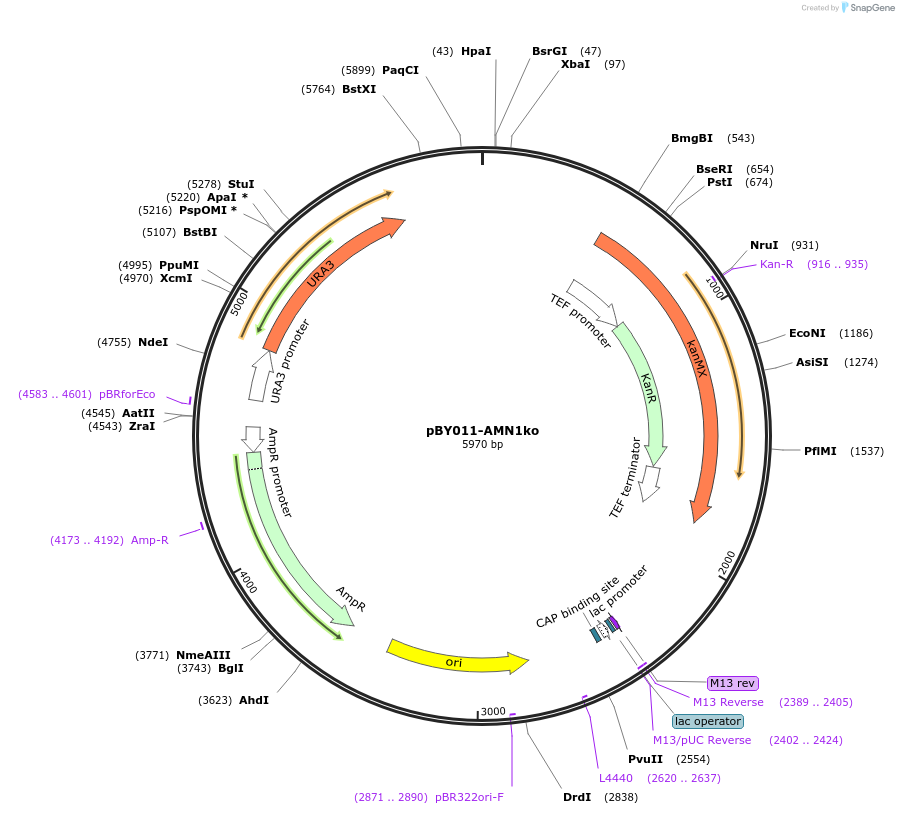pBY011-AMN1ko
(Plasmid
#183099)
-
PurposeS. cerevisiae Sigma1278b AMN1 gene knock out plasmid with KanMX selection marker.
-
Depositing Lab
-
Sequence Information
Ordering
| Item | Catalog # | Description | Quantity | Price (USD) | |
|---|---|---|---|---|---|
| Plasmid | 183099 | Standard format: Plasmid sent in bacteria as agar stab | 1 | $89 | |
Backbone
-
Vector backbonepBY011
-
Backbone manufacturerHarvard Medical School
- Backbone size w/o insert (bp) 3607
- Total vector size (bp) 5972
-
Modifications to backboneNone
-
Vector typeBacterial Expression, Yeast Expression
-
Selectable markersNeomycin (select with G418)
Growth in Bacteria
-
Bacterial Resistance(s)Ampicillin, 100 μg/mL
-
Growth Temperature37°C
-
Growth Strain(s)DH5alpha
-
Copy numberHigh Copy
Gene/Insert
-
Gene/Insert nameAMN1 (left homology arm) - KanMX - AMN1 (right homology arm)
-
Alt nameAMN1 (YBR158W)
-
SpeciesS. cerevisiae (budding yeast)
-
Insert Size (bp)2365
-
Mutationonly includes external sequences (504 bp each) as homology arms, separated by KanMX
-
GenBank IDEEU05423 EEU05423.1
-
Entrez GeneAMN1 (a.k.a. YBR158W, CST13, ICS4)
- Promoter URA3, TEF1
-
Tag
/ Fusion Protein
- KanMX
Cloning Information
- Cloning method Gibson Cloning
- 5′ sequencing primer GAACTAACAAAAACGTTCAAAAAGTTT
- 3′ sequencing primer AACACTATGAGTGTATCTTTTGGAG
- (Common Sequencing Primers)
Resource Information
-
Supplemental Documents
Terms and Licenses
-
Academic/Nonprofit Terms
-
Industry Terms
- Not Available to Industry
Trademarks:
- Zeocin® is an InvivoGen trademark.
These plasmids were created by your colleagues. Please acknowledge the Principal Investigator, cite the article in which the plasmids were described, and include Addgene in the Materials and Methods of your future publications.
-
For your Materials & Methods section:
pBY011-AMN1ko was a gift from Gabor Balazsi (Addgene plasmid # 183099 ; http://n2t.net/addgene:183099 ; RRID:Addgene_183099) -
For your References section:
Drug-dependent growth curve reshaping reveals mechanisms of antifungal resistance in Saccharomyces cerevisiae. Guinn L, Lo E, Balazsi G. Commun Biol. 2022 Mar 31;5(1):292. doi: 10.1038/s42003-022-03228-9. 10.1038/s42003-022-03228-9 PubMed 35361876







